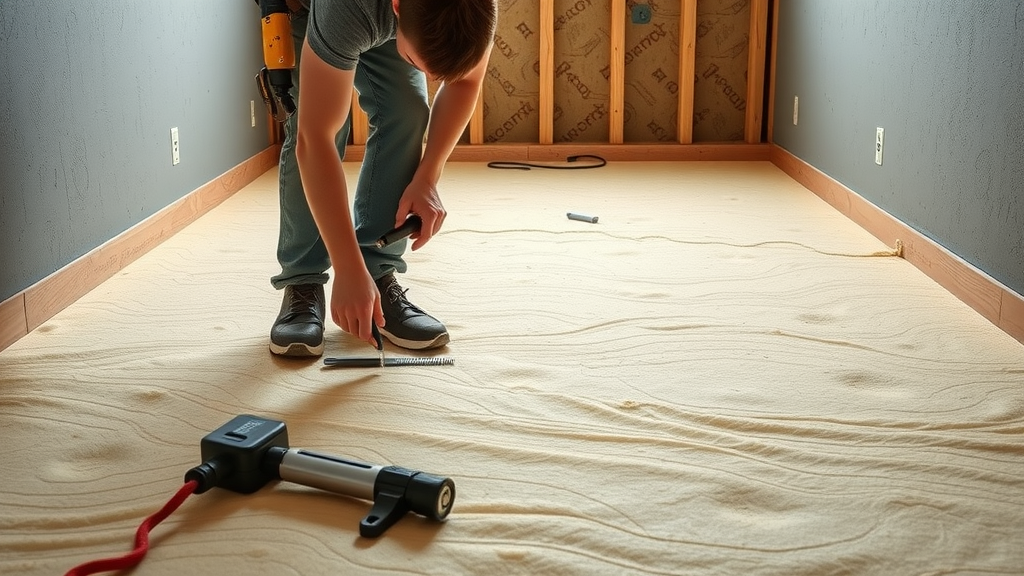Have you ever wondered if your favourite flooring could actually be holding your underfloor heating back? Choosing the best type of flooring with UFH isn’t just about looks or budget—it's about maximising comfort, energy efficiency, and the overall performance of your heating system. Getting this crucial decision right means your home feels cosier, your bills stay lower, and your investment lasts longer. In this guide, we uncover what truly works underfoot, so you can enjoy warmth, style, and peace of mind with every step.
Opening Inquiry: Challenging the Conventional Choice – What Really is the Best Type of Flooring with UFH?
It’s easy to accept what’s popular, but is it truly the best flooring for underfloor heating? Many believe that any floor covering will work, or that “hard floors are always best.” The truth is, the type of flooring you choose has a dramatic impact on heat output, energy usage, and even the longevity of your system. As property owners increasingly retrofit UFH in modern and traditional homes alike, the importance of selecting the right floor finish grows ever more critical. So, what factors matter most, and which flooring types provide the perfect balance of warmth, durability, and style for underfloor heating? Let’s challenge conventions and uncover how you can confidently choose the best type of flooring with UFH for your space.
"With so many ‘best flooring’ claims on the market, choosing the best type of flooring with UFH requires a careful, tailored approach."
What You'll Learn: Mastering Flooring Selection for Underfloor Heating
- Core principles for choosing the best type of flooring with UFH
- In-depth comparisons of popular floor covering materials
- Expert insights into heat output, energy efficiency, and comfort
- Installation tips to maximise longevity and performance
- Professional guidance from Peak Underfloor Heating Ltd

Understanding Underfloor Heating Systems: The Foundation for Flooring Success
Types of Underfloor Heating (water-based & electric heating systems) and Their Impact on Best Flooring Choices
The two most common underfloor heating systems are water-based (wet) and electric (dry) systems. Both types are designed to heat a space evenly and efficiently from underneath your chosen floor covering. Wet systems circulate warm water through pipes, while electric systems use wires or heating mats. Your choice between these can impact the best flooring for underfloor heating because certain materials respond differently to heat. Ceramic tile and stone work exceptionally well with both, thanks to their high thermal conductivity, meaning heat passes through quickly and evenly into your room. Engineered wood, laminate floor, and vinyl floors can also be excellent options if their specifications align with your system and manufacturer’s guidelines. In contrast, some flooring types like solid hardwood or thick carpets can insulate against the heat—reducing efficiency.

Key Considerations: Heat Output & Floor Finish Compatibility
To unlock the best performance from your UFH, it’s vital to consider each flooring option’s compatibility and heat output. Ceramic tile and polished screed are renowned for quick heat transfer, keeping your toes toasty with minimal energy loss. On the other hand, materials like engineered wood and LVT can be excellent if carefully chosen for their thickness and manufacturer-stated suitability. A floor covering with low tog rating (a measure of insulation) ensures more heat makes it into your living space rather than lingering underfoot. Always check both the heat output potential of your UFH system and the compatibility of your chosen floor finish, as well as recommended installation guides from flooring and heating manufacturers.
The Role of Heat Conductivity in Identifying the Best Type of Flooring With UFH
Heat conductivity may not be the most glamorous factor, but it’s critical in getting the most from your UFH system. Materials like ceramic tile and natural stone have the highest conductivity, allowing heat to rise quickly and evenly. Engineered wood and vinyl floor coverings are generally suitable for use with underfloor heating, provided you pick designs engineered to work with fluctuating temperatures. Remember, the best type of flooring with UFH will always be the one that lets warm air flow effortlessly upward, maximising comfort and keeping your energy bills in check.
Guide to the Best Flooring for Underfloor Heating: Materials Analysed
Ceramic Tile: A Top Choice for Best Flooring with Underfloor Heating
Ask any heating specialist and they’ll often recommend ceramic tile as the gold standard for the best flooring for underfloor heating. Renowned for its impressive heat output and low tog rating, ceramic tile rapidly conducts warmth from your underfloor heating up into your living spaces. Tiles heat up quickly and evenly, meaning you feel the benefit faster, and the heating system doesn’t have to work as hard—translating to noticeable energy efficiency. Moreover, ceramic tiles are durable, low-maintenance, and available in a vast range of colours and finishes to match any home style. If longevity, performance, and sleek aesthetics top your list, ceramic tile is one of the best floor coverings you can choose with UFH systems.

Porcelain and Stone: Maximum Heat Output and Floor Finish Durability
For homeowners seeking maximum warmth and an ultra-luxurious finish, porcelain and stone tiles are hard to beat. Their high density and naturally superior thermal conductivity deliver outstanding heat transfer and a consistent, comfortable floor temperature. Both are also tough enough to handle heavy foot traffic, making them ideal floor covering choices in kitchens, bathrooms, and open-plan living areas. With practically limitless design options—think polished marble, rustic slate, or modern travertine—these materials deliver both beauty and unbeatable performance. While installation might cost a little more same as the ufh system itself, the investment pays off with warmth, style, and decades of comfort.
Engineered Wood Flooring: Style, Stability, and Best Floor for Underfloor Heating
Looking for warmth paired with timeless character? Engineered wood flooring is ideal for underfloor heating—as long as you select a product specifically certified as suitable for use with UFH. Unlike solid hardwood, engineered wood is constructed with multiple layers to resist warping, expansion, and contraction when exposed to changes in temperature and moisture. This leads to a stable, stylish, and welcoming finish while still allowing effective heat transfer. Always check the manufacturer’s tog rating and installation guidelines. When done right, engineered wood offers one of the best floors for underfloor heating in living rooms, hallways, or bedrooms.

Laminate Flooring for Underfloor Heating: Practicality and Performance
Laminates have come a long way, and laminate flooring can be a practical, cost-effective flooring for underfloor heating—with the right product. Look for laminates certified as suitable for use with UFH, ideally with a low tog rating for optimum heat output. Laminate’s multi-layer construction provides stability, and advanced click-fit systems make professional installation a breeze. The top surface resists scratches and spills, making it perfect for busy homes. While not as conductive as tile or stone, quality laminate floors will effectively transmit warmth if kept below the recommended thickness (typically under 8mm for the best performance). That means you can enjoy easy maintenance, stylish finishes, and lasting comfort with your underfloor heating system.
Luxury Vinyl Tile (LVT) and Vinyl Floor: Modern Options for Flooring with Underfloor Heating
Modern vinyl floor solutions like LVT (luxury vinyl tile) have quickly become favourites for UFH retrofits. These high-tech, resilient floors deliver excellent resistance to moisture and are warm underfoot, even before the heating comes on. LVT is thin (low tog rating), so it offers quick heat transfer—perfect for bathrooms, kitchens, and even living rooms. It’s a breeze to clean, with a wide range of patterns and styles from stone-looks to realistic wood grains. Vinyl is also forgiving of minor subfloor imperfections, making installation simpler. The key is to ensure your chosen LVT or vinyl is explicitly rated as suitable for use with underfloor heating systems, as older or basic products may warp or delaminate when repeatedly heated and cooled.

Polished Screed & Concrete Floors: Contemporary Flooring Covering for UFH Projects
Polished screed and concrete may sound industrial, but these floors are ultra-modern, high-performing choices for open-plan spaces. Their excellent heat conductivity means you get quick, even heating. Polished screed gives a smooth, seamless look, perfect for minimalist interiors, while modern concrete can be finished in a huge spectrum of colours and textures. Both options are easy to clean, resistant to moisture, and ideal for areas with frequent foot traffic. For the best performance, work with a professional UFH installer to ensure even distribution and proper curing, so you can enjoy ultra-efficient comfort and a contemporary aesthetic for decades to come.

Comparing Flooring Types: Which is the Best Type of Flooring with UFH?
| Flooring Type | Heat Output | Durability | Style/Finish | Maintenance | Suitability for UFH |
|---|---|---|---|---|---|
| Ceramic Tile | Excellent | High | Wide variety | Easy | ★★★★★ |
| Engineered Wood | Very Good | High | Classic/Warm | Medium | ★★★★★ |
| Laminate Floor | Good | Medium | Modern/Varied | Easy | ★★★★ |
| LVT/Vinyl Floor | Good | High | Imitates wood/stone | Very Easy | ★★★★ |
| Polished Screed/Concrete | Excellent | High | Modern/Sleek | Easy | ★★★★★ |
| Carpet (Thin/Low Tog) | Fair | Medium | Soft/Varied | Medium | ★★★ |
| Solid Hardwood | Poor | High | Classic | Medium | ★ |
| Thick Carpet | Poor | Medium | Soft | Medium | ★ |
Factors Affecting the Best Flooring for Underfloor Heating
Thermal Conductivity: Key to Best Type of Flooring With UFH
The most important measure of how well a floor covering works with underfloor heating is its thermal conductivity. Simply put, the higher the conductivity, the more efficiently warmth flows from the heating system to the surface (and into your home). Ceramic tile, stone, polished screed, and certain LVT products rank highest for rapid heat transfer. Engineered wood and laminate can also perform excellently, provided their thickness and construction are UFH-friendly. Always look for a low tog rating—under 1.5 is recommended for optimum efficiency. This ensures you aren’t losing precious heat and every unit of energy is used to warm your room, not the subfloor.

Expansion, Contraction, and the Problem of Moisture
Underfloor heating systems repeatedly heat and cool floors, putting every material through its paces. Natural wood and some laminates expand and contract more than ceramics or polished concrete, so selecting engineered wood or properly rated laminate floor is essential to avoid cracking or warping. Also, bathrooms and kitchens face greater moisture exposure—choose LVT, tile, or sealed concrete for minimal risk. Always ensure the floor finish is certified for use with underfloor heating, and follow manufacturer installation recommendations for expansion gaps and underlayment choices. A little care here saves major headaches later.
Floor Finish, Installation, and Ongoing Maintenance
The choice of floor finish not only influences comfort but also how easy your floor will be to install and maintain. Ceramic tile, vinyl flooring, and polished screed are all straightforward to clean and highly durable with minimal upkeep. Engineered wood and laminate flooring are simple to install and can often be easily replaced in sections, but require more attention to correct acclimatisation and regular cleaning. Investing in a floor finish that matches both your aesthetic and lifestyle is the key to getting the most value and performance from your underfloor heating system.
Flooring Types and Their Performance with Underfloor Heating Systems
Best Floor Covering for Each Heating System Type (Electric vs. Wet)
The best type of flooring with UFH also depends on whether you’re using a water-based (wet) or electric system. Wet systems tend to be found in larger spaces or whole-house installations, where ceramic tile, stone, and polished screed are ideal for efficient, uninterrupted heat output. Engineered wood and LVT also perform superbly provided the correct product is selected. Electric systems, often used in single rooms or retrofits, can pair well with tile, LVT, and certain laminate floor products. However, always confirm the floor covering and installation method are suited to your chosen heating system’s specifications for maximum safety and performance.
Avoid These: Flooring Types Not Suitable for Underfloor Heating
- Solid hardwood flooring
- Thick or dense carpets
- Traditional cork flooring
- Non-compatible vinyl or rubber materials
"The wrong flooring type can reduce the efficiency, comfort, and lifespan of your underfloor heating system."
Installation Tips: Maximising the Best Type of Flooring With UFH
Correct Floor Preparation and Best Floor Finish for Underfloor Heating
Proper installation of your floor covering is as important as choosing the right material. Start with a flat, well-insulated subfloor to stop heat loss, and always use recommended underlays and vapour barriers. For tile, LVT, and polished screed, adhesives and grouts must be high quality and compatible with UFH’s temperatures. Engineered wood and laminate flooring require careful acclimatisation to prevent post-installation movement. Preparing the subfloor and following specific manufacturer guidelines for expansion gaps ensures your new best flooring for underfloor heating stays flawless for years.

Controlling Floor Temperature and Avoiding Overheating
Install a precise, programmable thermostat to keep your floor at the optimum temperature—usually 27–29°C for most types of floor. Overheating can cause laminate and engineered wood to move, or some adhesives to fail. Many advanced underfloor heating systems let you monitor and adjust floor temperatures remotely, ensuring consistent comfort and extended floor life. If you’re switching on UFH for the first time, increase temperature gradually to reduce the risk of cracks or warping—especially for new tiles or concrete screeds.
Working with Professional UFH Installers (Peak Underfloor Heating Ltd)
Choosing the best type of flooring with UFH is a big decision, but expert support makes it easy. The team at Peak Underfloor Heating Ltd brings years of hands-on experience to every project, ensuring you get tailored advice, professional installation, and results you can count on. Working with skilled professionals reduces the risk of costly mistakes, prolongs the lifespan of your entire system, and guarantees you get the most out of your investment—every single day.
Key Takeaways: How to Choose the Best Flooring for Underfloor Heating
- Evaluate floor covering materials for conductivity and comfort
- Consider room usage and traffic patterns
- Check manufacturer compatibility with heating system
- Always consult UFH experts for tailored recommendations
People Also Ask: Your Flooring With UFH Questions Answered
What is the best flooring for underfloor heating?
The best flooring for underfloor heating is a floor covering with high thermal conductivity and stable performance under changing temperatures. Ceramic tile, stone, and polished screed are top choices because they conduct heat efficiently, offering quick warm-up times and outstanding durability. Engineered wood and LVT are excellent too, provided they’re designed specifically for UFH compatibility and installed according to expert guidelines.
What flooring is not suitable for underfloor heating?
Flooring types to avoid include solid hardwood, thick or dense carpets, traditional cork flooring, and non-compatible vinyl or rubber finishes. These materials tend to insulate rather than transmit heat, drastically reducing heat output, increasing energy bills, and risking long-term damage to both flooring and heating system. Always choose a material proven and tested for UFH.
Is LVT or laminate better for underfloor heating?
Both LVT (luxury vinyl tile) and laminate flooring can perform well with underfloor heating if chosen carefully. LVT is generally thinner and has slightly higher thermal conductivity, which means quicker heat-up times and more consistent surface warmth. Laminate flooring offers a hard-wearing, budget-friendly option, but must be a type specifically rated as suitable for use with underfloor heating to stay stable and safe. Always check tog ratings and manufacturer recommendations for both.
What type of flooring works best with radiant heat?
For radiant heat systems, ceramic tile, stone, polished screed, and certain engineered wood or LVT designs are the best floors for underfloor heating. These materials offer rapid, even heat transfer and lasting durability while maintaining your chosen aesthetic. Consult your underfloor heating installer to confirm suitability before you buy.
FAQs: Choosing Your Best Type of Flooring with UFH
-
Q: Can I install any type of flooring with underfloor heating?
A: No. Always check the floor covering’s suitability with the heating manufacturer. Stick to low-tog, UFH-certified products for the best results. -
Q: Does underfloor heating work with carpet?
A: It can, but only with a thin, low tog rating carpet and appropriate underlay. Avoid thick or dense carpets that hinder heat output. -
Q: Should I worry about expansion gaps with wood or laminate flooring?
A: Absolutely. Allow room for proper expansion to avoid buckling as temperatures fluctuate. -
Q: What is the ideal floor temperature for UFH?
A: Most systems recommend floor temperatures between 27–29°C for safe, comfortable heating.
Conclusion: Why the Best Type of Flooring with UFH Is Key to Comfort—And Why Peak Underfloor Heating Ltd Delivers Results
Choosing the best type of flooring with UFH combines science, style, and expert support. With trusted advice and professional installation from Peak Underfloor Heating Ltd, you can achieve unmatched comfort and energy efficiency for years to come.
Ready to Select and Install Your Best Flooring for Underfloor Heating?
Contact Peak Underfloor Heating Ltd today for a free consultation, tailored recommendations, and expert installation services—your home’s comfort starts here.
"Partnering with Peak Underfloor Heating Ltd ensures your flooring and heating system are a seamless, efficient union from start to finish."
Sources
- Underfloor Heating Trade – https://www.underfloorheatingtrade.co.uk/blog/best-flooring-for-underfloor-heating
- Ideal Home – https://www.idealhome.co.uk/project-advice/best-flooring-for-underfloor-heating-296040
- Energy Saving Trust – https://www.energysavingtrust.org.uk/advice/underfloor-heating
Selecting the appropriate flooring for underfloor heating (UFH) is crucial to ensure optimal heat transfer, energy efficiency, and the longevity of both the flooring and heating system. Materials with high thermal conductivity and stability under temperature fluctuations are ideal.
Top Flooring Options for Underfloor Heating:
-
Tile and Stone Flooring:
- Thermal Conductivity: Excellent; these materials quickly absorb and radiate heat, ensuring efficient warmth distribution.
- Durability: Highly durable and resistant to temperature changes, making them suitable for high-traffic areas.
- Aesthetic Variety: Available in numerous styles and finishes to complement various interior designs.
- Maintenance: Easy to clean and maintain.
Note: Natural stone may require sealing to prevent stains and maintain its appearance. (griffithflooringservice.com)
-
Engineered Wood Flooring:
- Thermal Conductivity: Good; the layered construction allows for effective heat transfer.
- Stability: More stable than solid hardwood, reducing the risk of warping or shrinking with temperature changes.
- Aesthetic Appeal: Provides the classic look of wood with added durability.
- Maintenance: Requires regular care to maintain its finish.
Note: Ensure the engineered wood is specifically designed for UFH compatibility. (buildpro.ie)
-
Laminate Flooring:
- Thermal Conductivity: Moderate; thin construction allows for reasonable heat transfer.
- Stability: Resistant to warping under temperature fluctuations.
- Aesthetic Variety: Available in various designs, mimicking wood, stone, or tile.
- Maintenance: Easy to clean and maintain.
Note: Choose high-quality laminate specifically rated for UFH to ensure optimal performance. (house2homeflooring.com)
-
Luxury Vinyl Tile (LVT):
- Thermal Conductivity: Good; thin layers facilitate efficient heat transfer.
- Durability: Highly durable and water-resistant, suitable for areas prone to moisture.
- Aesthetic Variety: Mimics the appearance of wood, stone, or tile.
- Maintenance: Easy to clean and maintain.
Note: Ensure the LVT is compatible with UFH systems to prevent potential damage. (ricesflooringanddesign.com)
Flooring Types to Avoid with Underfloor Heating:
- Solid Hardwood: Prone to warping and shrinking due to temperature fluctuations.
- Thick Carpets: High insulation properties can impede heat transfer, reducing system efficiency.
- Traditional Cork Flooring: May not withstand the temperature changes associated with UFH.
- Non-Compatible Vinyl or Rubber Materials: Some may not be designed to handle the heat from UFH systems.
Note: Always consult with flooring and UFH manufacturers to ensure material compatibility. (fastwarm.com)
Key Considerations:
- Thermal Conductivity: Opt for materials that efficiently transfer heat to maximize system performance.
- Stability: Choose flooring that remains stable under temperature changes to prevent damage.
- Thickness: Thinner materials generally allow for better heat transfer; however, ensure they are durable enough for your needs.
- Manufacturer Guidelines: Always adhere to the recommendations provided by both the flooring and UFH system manufacturers to ensure compatibility and maintain warranties.
By carefully selecting the right flooring material and following manufacturer guidelines, you can enhance the efficiency and comfort provided by your underfloor heating system.
 Add Row
Add Row  Add
Add 









Write A Comment